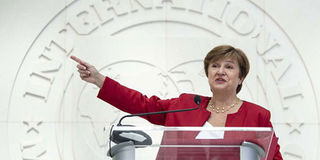Debt relief most effective Covid-19 aid package

Newly-selected International Monetary Fund (IMF) Managing Director Kristalina Georgieva speaks at a press conference at the IMF headquarters on September 25, 2019, in Washington. PHOTO | ERIC BARADAT | AFP
What you need to know:
- If ever there was a moment to expand the use of the international currency known as Special Drawing Rights (the IMF’s global reserve asset), it is now.
- The IMF, World Bank and regional development banks need to be as aggressive as the central banks in expanding their lending.
The developed world has responded to the Covid-19 crisis by supporting their domestic economies and financial systems in bold and unprecedented ways, on a scale unimaginable three months ago.
In contrast, when the world’s finance and central bank governors convene virtually this week for the semi-annual International Monetary Fund-World Bank meetings, steps will be taken to fortify the international system. But nothing comparable to that.
Historians such as Charles Kindleberger have argued that failure of international cooperation made the depression of the 1930s “Great”. Even when there was coordinated response to crises since, it is often after a huge human cost.
The Bretton Woods conference on reconstructing the international financial system came after the devastation of a world war and the Brady Plan for resolving the Latin American debt after a lost decade.
The 2009 London G20 meeting on the global financial crisis, however, demonstrated the value of early and coordinated action to limit the damage to the global economy, maintain trade and support emerging markets.
The next wave of the Covid-19 crisis will occur in the developing world. Around 900,000 are likely to die in Asia and 300,000 in Africa, according to grim, but perhaps cautious, estimates from Imperial College London.
STARK REALITY
While social distancing is the West’s route to suppression of the virus, the developing world’s crowded cities and often overcrowded slums make it difficult.
Advice on handwashing means little where there is no access to running water. Without a basic social safety net, choices are narrow and stark: go to work and risk disease or stay home and starve with your family.
Pervasive economic and financial failure in emerging markets also threatens the viability of the supply chains on which all countries depend.
Given its magnitude, emerging-market debt threatens the stability of a global financial system dependent on strong central bank support.
And with emerging markets accounting for more than half of global GDP, global growth is threatened as well.
Just as the US Federal Reserve and other major central banks have expanded their balance sheets in previously unimaginable ways, the international community needs to do, in former European Central Bank President Mario Draghi’s famous phrase, “whatever it takes” to maintain a functioning global financial system.
At a time when the United States is borrowing an extra $2 trillion to meet its needs, it would be tragic if massive austerity was forced on a stressed developing world.
INCREASE LENDING
First, the IMF, World Bank and regional development banks need to be as aggressive as the central banks in expanding their lending.
This means recognising that the current near-zero interest-rate environment makes it possible to use more leverage than previously, and that there is little point in having reserves if they cannot be utilised now.
The World Bank nearly tripled its lending in 2009. An even more ambitious target may be appropriate now, along with increase in subsidised lending at a time when low borrowing rates in rich countries make it much less costly.
In addition to relieving debt interest payments, the IMF, with its $150 billion in gold reserves and network of credit lines with central banks, should lend up to $1 trillion.
Second, if ever there was a moment to expand the use of the international currency known as Special Drawing Rights (the IMF’s global reserve asset), it is now.
If global money is to stay in balance with the domestic monetary expansion in rich countries, an increase in SDRs of well over $1 trillion is urgently needed.
Third, it would be a tragedy and a travesty if stepped-up global financial support for developing countries ended up helping those countries’ creditors rather than their citizens.
SYSTEMIC APPROACH
National debts incurred before the crisis must be at the top of the international financial agenda.
We should agree now that once we have clarity on the economic fallout of the crisis, we will pursue the kind of systemic approach required to restore debt sustainability in emerging-markets and developing countries while safeguarding their prospects for new investment.
But the most immediate and largest short-term support can come from waiving upcoming debt payments by the 76 low- and lower-middle-income countries that are supported by the International Development Association.
The current proposal is that creditor countries would offer a six- or nine-month standstill on bilateral debt repayment, at $9-13 billion. But this is constricted.
We propose relieving over $35 billion due to official bilateral creditors over this year and next as the crisis will not be resolved in six months, and governments need to plan spending with certainty.
Mr Brown is a former Prime Minister and Chancellor of the Exchequer of the United Kingdom; Summers was US Secretary of the Treasury, Director of the US National Economic Council and President of Harvard University, where he is a professor. © Project Syndicate





